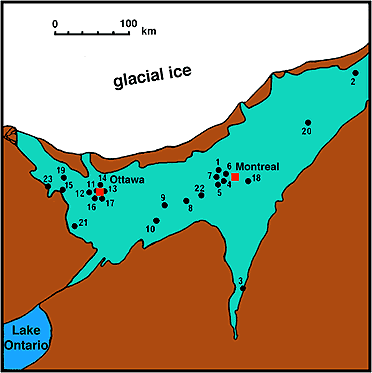Ottawa is found a in valley named the St. Lawrence
Lowland which is surrounded by Precambrian rocks of the Canadian Shield. The St. Lawrence Lowland
encompasses an area from eastern Ontario to western Quebec and northern New York. The St. Lawrence
Lowland area is composed of basement Precambrian rock overlain by Paleozoic sedimentary deposits which are overlain by
glacial deposits (Wilson, 1956).
The Precambrian basement, including the Gatineau hills, is part of the Grenville
Province composed of crystalline limestone. The Gatineau hills were formed by uplift and
erosion. Pillow lavas are found in the Grenville province. This indicates that there must have been a time when the area was submerged by water and intruded with volcanic material.
The Paleozoic sedimentary deposits occurred via a number of transgressions and
regressions of the ocean as a result of eustatic sea level rise (Lemon, 1993). The Epeiric
seas, or seas which covered the continent, covered the St. Lawrence Lowland for a
significant amount of time. There was deposition of limestones, sandstones and shales
during this time (Wilson, 1956). These are the deposits of the characteristically layered
sediment we see all over the city. For instance, the photo of Hogs Back Falls on the home page
illustrates the layering of shale and sandstone beds.

The glacial deposits were deposited as the glaciers of the latest period of
glaciation began their retreat. Erratics, glacial till and glacial stria can be found
easily in the Gatineau hills. The Gatineau hills are so rounded and hilly because of the
glaciation. Mountains were broken and crushed by the weight of the glaciers and smoothed
out by the mass of boulders and sediment carried at the base of the glaciers.